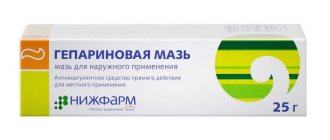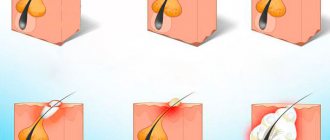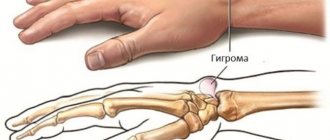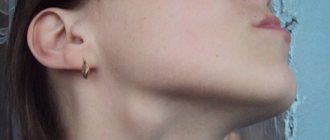Atheroma on the face is not just a cosmetic defect. It occurs due to blockage of the sebaceous glands. If infection penetrates inside, purulent inflammation may develop. Inflammation of atheroma on the face is very dangerous, especially if the process is located above the line of the mouth. This is due to the peculiarities of the blood supply to the head. The veins of the face drain into the venous sinuses of the skull, which leads to the rapid progression of the disease and the development of abscesses in the brain. The degree of danger of atheroma depends on other factors, including the size of the formation and the presence of underlying chronic diseases, such as diabetes. Therefore, when facial atheroma appears, treatment should only be carried out by a doctor.
Rice. 1 Facial atheroma occurs due to blockage of the sebaceous glands
Diagnosis of atheroma on the face
Atheroma looks like a small subcutaneous ball. The tumor itself does not resolve and gradually increases. With long-term existence, atheroma on the face can reach 7 cm in diameter. On its surface you can always see a black dot that blocks the sebaceous duct. Atheroma has clear boundaries and a spherical shape. The patient does not feel pain upon palpation. Visually, atheroma is similar to lipoma, hygroma, fibroma, hemangioma, so a doctor must make an accurate diagnosis. If there are difficulties in diagnosis, an MRI may be prescribed to determine the nature of the tumor. After removal of any formation, including atheroma, a histological examination is carried out.
Rice. 2 Atheroma looks like a small ball under the skin of the face
Causes of pathology
If the lymph node in the neck under the jaw is inflamed, then the possible causes are:
- diseases of infectious origin that affect the ENT organs and the upper parts of the respiratory system (tonsillitis, sinusitis, tonsillitis, laryngitis, pharyngitis, otitis media);
- diseases developing in the oral cavity (caries, periodontal disease, periodontitis, periostitis, or gumboil, pulpitis, gingivitis, alveolitis, stomatitis);
- systemic infections (measles, whooping cough, mumps, popularly called mumps, chicken pox);
- pathologies affecting the immune system (lymphomas, leukemia, lupus, HIV);
- neoplasms (benign or malignant) of various origins (atheromas, granulomas, lipomas, cysts);
- infections caused by parasitic microflora (lymphoreticulosis, toxoplasmosis);
- disruptions in the functioning of the immune system.
You should know that the above ailments are not always accompanied by inflammation of the lymph nodes. Quite often, the nodes remain in a normal state even if the disease is acute.
If the lymph node under the jaw is inflamed, then in 60% of cases the pathology is caused by dental problems, in 30% by diseases of the respiratory system. In 20% of cases, the reason why the lymph node under the jaw is inflamed and hurts is advanced caries, leading to the development of a purulent abscess. After tooth extraction or conservative treatment of caries, pathological processes in the lymph nodes stop.
But sometimes it is tooth extraction that can become a provoking factor and cause an enlarged lymph node. A similar situation is possible if an infection enters the hole.
The danger of atheroma on the face
Sebum and keratin masses accumulated in the atheroma capsule have a cheesy consistency. This is a favorable environment for the development of bacteria. An attempt to squeeze out the atheroma can lead to infection getting inside the capsule and causing suppuration. The main symptoms of its onset are:
- redness of the skin around the atheroma;
- pain in the affected area;
- Migraine-like headaches;
- temperature increase.
Inflamed atheroma can lead to phlegmon - inflammation of adjacent tissues without precise boundaries.
Rice. 3 Self-squeezing of atheroma usually leads to inflammation of facial tissues
Stages of disease development and symptoms
Lymphadenitis in its development goes through 3 stages:
- stage
– the lymph nodes take on the appearance of mobile, compacted tubercles, when pressure is applied to them, pain appears, the temperature rises, sleep is disturbed, and general weakness is detected;
- stage (purulent abscess)
– the lymph node enlarges more and hurts even if you don’t touch it, which limits the motor activity of the jaw, pus accumulates in the lymph node, the skin around it becomes red, and the temperature is constantly elevated;
- stage (purulent phlegmon)
– the tumor spreads to the lymph nodes located in the armpits, the pain intensifies significantly, the skin turns blue, the temperature rises to 40⁰.
Treatment of facial atheroma
Getting rid of atheroma using traditional methods of treatment, drugs of different release forms, or self-dissection is ineffective and dangerous . Atheroma can only be removed surgically along with the capsule. The smaller the formation, the easier the procedure will be and the greater the likelihood of being left without a scar on your face. Several methods of operating on atheroma on the face are practiced.
- Laser destruction of atheroma is the most effective and painless treatment method, after which there is no scar. Used to remove formations with a diameter of up to 5 mm.
- Laser excision of atheroma is an innovative treatment method that does not require a recovery period.
- The classic operation with a scalpel is the removal of atheroma. It is performed under local anesthesia.
During the inflammatory process, the doctor cleans out the contents and disinfects the atheroma cavity, then performs an operation to remove the capsule and, if necessary, the affected tissue. Even if the atheroma does not bother you and “does not spoil the beauty,” it still needs to be removed. Pressure on nearby tissues causes them to become deformed, and the possibility of inflammation puts your health at risk.
Diagnostic method
A neoplasm can be diagnosed, even in the absence of symptoms and pain, using MRI of the soft tissues of the cervical spine.
The examination will reveal the formation, determine the size, as well as connections with other vessels, tissues and organs. As for choosing a doctor, it directly depends on the type of lump. If the diagnosis shows enlarged lymph nodes, then it is advisable to consult a therapist. The doctor will determine the reason why the lump on the neck is growing and give recommendations for treatment.
Since the appearance of a cyst on the neck is often a consequence of tonsillitis, advanced caries or sore throat, you will need to consult an otolaryngologist and dentist. A dermatologist will give recommendations on the safe performance of cosmetic surgeries and the treatment of skin diseases.
If a malignant neoplasm is suspected, the therapist will refer you to an oncologist. If a formation is diagnosed that cannot be treated with medication, but is removed, they are referred to a surgeon.
When visiting a doctor, the patient initially undergoes a visual examination, after which the doctor will make an accurate diagnosis and prescribe treatment. To determine the full clinical picture, you will be referred for additional examinations (computer and magnetic resonance imaging, ultrasound, blood tests, etc.).
Also, if a malignant tumor is suspected, the doctor will prescribe a biopsy of the affected tissue for histological examination of the samples.
Symptoms
Symptoms of tumors and swellings in the neck:
- hoarseness of voice;
- swelling in the neck;
- aching pain;
- difficulty eating.
The symptoms of tumors and swellings in the neck are not very characteristic, and therefore it is not always possible to identify the disease in time
If symptoms get worse, the tumor is likely growing in size, which can be life-threatening. In this case, you must immediately undergo diagnostics and consult a specialist.
Secondary risk factors
Below are described the secondary signs that serve as the basis for the appearance of tumors and swellings.
Floor
Neck tumors are more common in men. On average, up to 80% of cases of complaints regarding this matter were made by men (according to statistics from WHO). However, the number of women suffering from neck tumors is rapidly changing, as more and more representatives of the fair sex are now abusing alcohol and cigarettes.
Males are more likely to suffer from neck tumors
The ratio of men to women affected by this pathology is 3 to 1. According to studies that have been conducted over the past five years, this imbalance will continue.
Age
Most often, people over 50 years of age suffer from tumors in the neck area, but recently young people aged 25-35 years have increasingly begun to report this complaint.
The disease is getting younger - more and more young people are suffering from this disease
In addition, young people have problems diagnosing the disease due to the too long list of possible causes that must first be “weeded out.”
Climatic conditions
It is noteworthy that the risk of developing a tumor, for example, in India, is almost six times higher than in Scandinavia.
The climatic conditions in which a person lives directly affect the chance of a tumor appearing in the neck area
According to scientists, the high incidence rate in Asia is a consequence of common habits in the area, such as chewing betel nut and using smokeless tobacco. The high increase in the incidence of this pathology in Russia is caused by smoking and alcoholism.
How to avoid a lump on your neck
It is not always possible to prevent the formation of a seal. The fact is that fibromas and lipomas have a genetic predisposition, while chemodectomas and cysts appear when leading an incorrect lifestyle. As for other types of formations, their appearance is avoided by adhering to the recommendations:
- treat skin diseases in a timely manner;
- It is advisable to be examined after injuries;
- lead a healthy lifestyle, since smoking, alcohol abuse and other bad habits significantly increase the risk of developing cancer;
- at the slightest suspicion and symptoms, consult a doctor to prevent the development of serious complications.
Causes of acne on the chin
Acne on the chin (as well as in other areas of the body such as the nose or roof of the mouth) can be caused by a variety of factors. We'll tell you about the most common ones.
Poor nutrition
First of all, acne on the chin may indicate that there is a junk food in your diet that is causing your acne, or perhaps a food allergy is present. People who are prone to allergic reactions to certain foods and do not have a balanced diet are most likely to suffer from spots and pimples on their chin This is because acne on the chin is associated with disorders in the small intestine, especially those caused by food allergies or an unhealthy diet.
Hormonal imbalance
Secondly, acne may be caused by hormonal changes if it appears during your menstrual cycle, pregnancy or menopause, or during puberty. For example, your body may be prone to pimples will begin to appear, and when finished they will gradually begin to disappear.
Polycystic ovarian syndrome
In this case, the level of sex hormones is not normal. Usually the ovaries produce small amounts of male sex hormones (androgens). In polycystic ovarian syndrome, the androgen level is slightly elevated. This can lead to the cessation of ovulation, as well as the appearance of acne and the growth of additional hair on the face and body.
Accumulation of toxic substances in the body
In this case, your body is unable to get rid of toxic substances. The accumulation of these toxins can lead to acne on the chin.
Stress
You must have noticed that during stressful situations, when you are nervous or worried, such as before a date or an important exam, your skin condition can generally worsen, and with anxiety and stress comes acne.
The exact cause is not yet known, but since the cells that produce subcutaneous fat have receptors and nerve endings, there is some sort of connection between stress and acne.
If you lead a busy lifestyle, you also become prone to developing pimples on your chin. They can multiply from a moderate amount to a very large amount, depending on your level of anxiety. Stress caused by family problems, social or professional life is enough to cause sudden changes in the amount. acne on your face, especially in the chin area.
Insufficient personal hygiene
Not paying enough attention to personal hygiene can cause acne to appear on a larger scale than before, as well as worsen the condition of existing acne.
Frequently touching the skin of your chin and neck with a dirty mobile phone, especially if you have a habit of holding your mobile phone against your chin and neck and have frequent and prolonged conversations, can expose acne-causing germs to your mobile devices. , will cause the formation of more and more acne on the chin and face.
Likewise, dirty musical instruments such as the violin can cause acne if they come into frequent contact with your chin.
Do not touch your face or chin with dirty hands, and do not prop your face or chin with your elbow, or support your head with your hands.
Internal pimple on chin photo
Prevention
To prevent the recurrence of tumors or swelling in the neck area, the following preventive measures are recommended.
- You need to say “no” to bad habits. To eliminate any favorable conditions for the development of tumors and swellings in the neck area, you need to stop drinking alcohol and smoking. The disappearance of these two bad habits from a person’s life significantly reduces the chance of cancer recurrence, which can cause a tumor.
- Get vaccinated. Today, human papillomavirus (HPV) vaccines help fight oropharyngeal and neck cancer.
- Sports activities. Everyone knows about the benefits of physical exercise for human health. Anyone who plays sports has a strong immune system and a well-developed body physically. This gives natural resistance to most diseases.
- Exposure to the sun should be done in moderation. Many people love to sunbathe, but not everyone benefits from the sun equally. After treatment for a tumor, it is better to be less exposed to direct sunlight and tightly cover the places where the tumor was once located. This will avoid a possible relapse.











